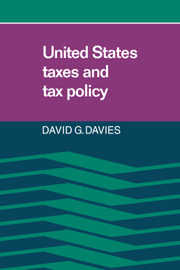Book contents
- Frontmatter
- Contents
- Preface
- 1 Economic foundations of U.S. tax policy
- 2 The individual income tax
- 3 Economic effects of individual income taxes and inflation
- 4 Expenditure versus income taxation
- 5 The taxation of capital gains
- 6 The corporation income tax
- 7 The corporation income tax and inflation
- 8 Social security payroll taxes
- 9 The value added tax
- 10 The sales tax
- 11 State taxes
- 12 Local government taxes
- 13 The distribution of tax burdens
- 14 Status of U.S. taxes and policy
- Appendix
- References
- Index
8 - Social security payroll taxes
Published online by Cambridge University Press: 05 May 2010
- Frontmatter
- Contents
- Preface
- 1 Economic foundations of U.S. tax policy
- 2 The individual income tax
- 3 Economic effects of individual income taxes and inflation
- 4 Expenditure versus income taxation
- 5 The taxation of capital gains
- 6 The corporation income tax
- 7 The corporation income tax and inflation
- 8 Social security payroll taxes
- 9 The value added tax
- 10 The sales tax
- 11 State taxes
- 12 Local government taxes
- 13 The distribution of tax burdens
- 14 Status of U.S. taxes and policy
- Appendix
- References
- Index
Summary
The United States payroll tax began under authorization of the Social Security Act of 1935. This law established two important social programs: one for retirement benefits and the other for unemployment compensation. Each has exerted a powerful influence on the economy, but social security is the largest and most pervasive of the two programs.
Several programs now comprise what is popularly known as social security. The original statute was designed strictly to provide retirement benefits to workers covered by the law and was called old age insurance (OAI). By 1939, Congress had changed the law to provide survivior benefits, and the system became known as OASI. When disability benefits were added in 1954, the program was immediately renamed OASDI. The last major functional expansion came in 1965 with the adoption of medicare and, predictably, the social security program became known as old age survivors, disability, and health insurance or OASDHI (Social Security Administration 1982a: 1–20). Today, it is the largest government program in the United States.
Early history
Weaver (1982:58–124) has written an excellent history of social security, in which she relates its controversial beginning. The program was started partly in response to the depressed economic conditions of the 1930s. Savings that had been set aside for retirement were lost in the economic turmoil of the times; unemployment was at an unprecedented high level; and middle-aged workers were hard pressed to provide for their immediate families, without the added burden of providing for their aged parents.
- Type
- Chapter
- Information
- United States Taxes and Tax Policy , pp. 168 - 199Publisher: Cambridge University PressPrint publication year: 1986



